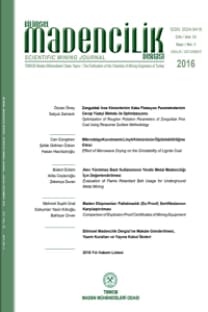KAYAÇ TANE BOYUTUNUN AŞINDIRICI SU JETİ (ASJ) KESME PERFORMANSINA ETKİSİ
Aşındırıcı su jeti (ASJ), malzemelerin kesilmesi ve/veya işlenmesinde yaygınlıkla kullanılan bir teknolojidir. Yöntemde, yüksek hız ve basınçtaki suyun malzeme yüzeyine püskürtülmesiyle kesme işlemi gerçekleştirilir. ASJ kesme performansının göstergelerinden olan kesme derinliği, kesilen malzemenin yüzey kalitesi ve yarık (kerf) açısı, işlem parametreleri (kesme hızı, aşındırıcı besleme miktarı, çalışma basıncı vb.) ve kesilen malzemenin özelliklerine bağlı olarak değişmektedir. Bu çalışmada, kayaç tane boyutunun ASJ kesme performansına etkisi deneysel olarak araştırılmıştır. Bu amaçla; mineralojik bileşimleri benzer olan farklı tane boyutuna sahip granit örnekleri ASJ ile kesilmiştir. Kesme sonrası her bir örneğin kesme derinliği, yüzey pürüzlülüğü ve kerf açısı ölçülmüştür. Çalışma sonucunda, kayaç tane boyutunun küçülmesiyle yüksek kesme derinliklerinin elde edildiği görülmüştür. Ayrıca, ince taneli kayaçların kesme yüzeylerinin iri tanelilere nazaran daha fazla pürüzlü olduğu tespit edilmiştir. Öte yandan, iri taneli kayaçlarda büyük kerf açıları elde edilirken ince taneli kayaçlarda daha küçük kerf açıları elde edilmiştir
Anahtar Kelimeler:
Aşındırıcı Su Jeti, Granit, Tane Boyu, Kesme Performansı
Effect of the Rock Grain Size on the Cutting Performance of Abrasive Waterjet (AWJ)
Abrasive water jet (AWJ) is a technology commonly used in machining and/or processing of materials. In the technique, the cutting process is performed by high speed and pressured water penetrating to material. The cut depth, quality of cut and kerf angle which are indicators for AWJ cutting performance, are changed depending on the process parameters (e.g. traverse speed, abrasive flow rate, water pressure etc.) and the properties of material to be cut. In this study, effect of the rock grain size on the cutting performance of AWJ was experimentally investigated. In this respect, granite samples which are similar in mineralogical composition, but diverse in grain size were cut by AWJ. Following the cutting; the cut depth, the surface roughness and the kerf angle of each sample were measured. As a result of the study, it was seen that higher cut depths were obtained when the grain size of the rock decreased. In addition, it was determined that the cut surface of fine-grained rocks was rougher than the cut surface of coarse-grained rocks. On the other hand; bigger kerf angles were obtained in coarsegrained rocks, whereas small kerf angles were obtained in fine-grained rocks (granites)
Keywords:
Abrasive Water Jet, Granite, Grain Size, Cutting Performance,
- ISSN: 2564-7024
- Yayın Aralığı: Yılda 4 Sayı
- Yayıncı: TMMOB Maden Mühendisleri Odası
Sayıdaki Diğer Makaleler
MADEN ATIK ALANLARININ KAPATILMASI - ÖRTÜ KAPLAMALAR
ZONGULDAK TAŞKÖMÜRÜ HAVZASI KÖMÜR İŞLETMELERİNDE VERİMLİLİK ANALİZİ
KAYAÇ TANE BOYUTUNUN AŞINDIRICI SU JETİ (ASJ) KESME PERFORMANSINA ETKİSİ
İzzet KARAKURT, Gökhan AYDIN, Kerim AYDINER
LİÇ PROSESİNDE KULLANIM AMACIYLA KALSİNE ULEKSİT HAZIRLANMASI
